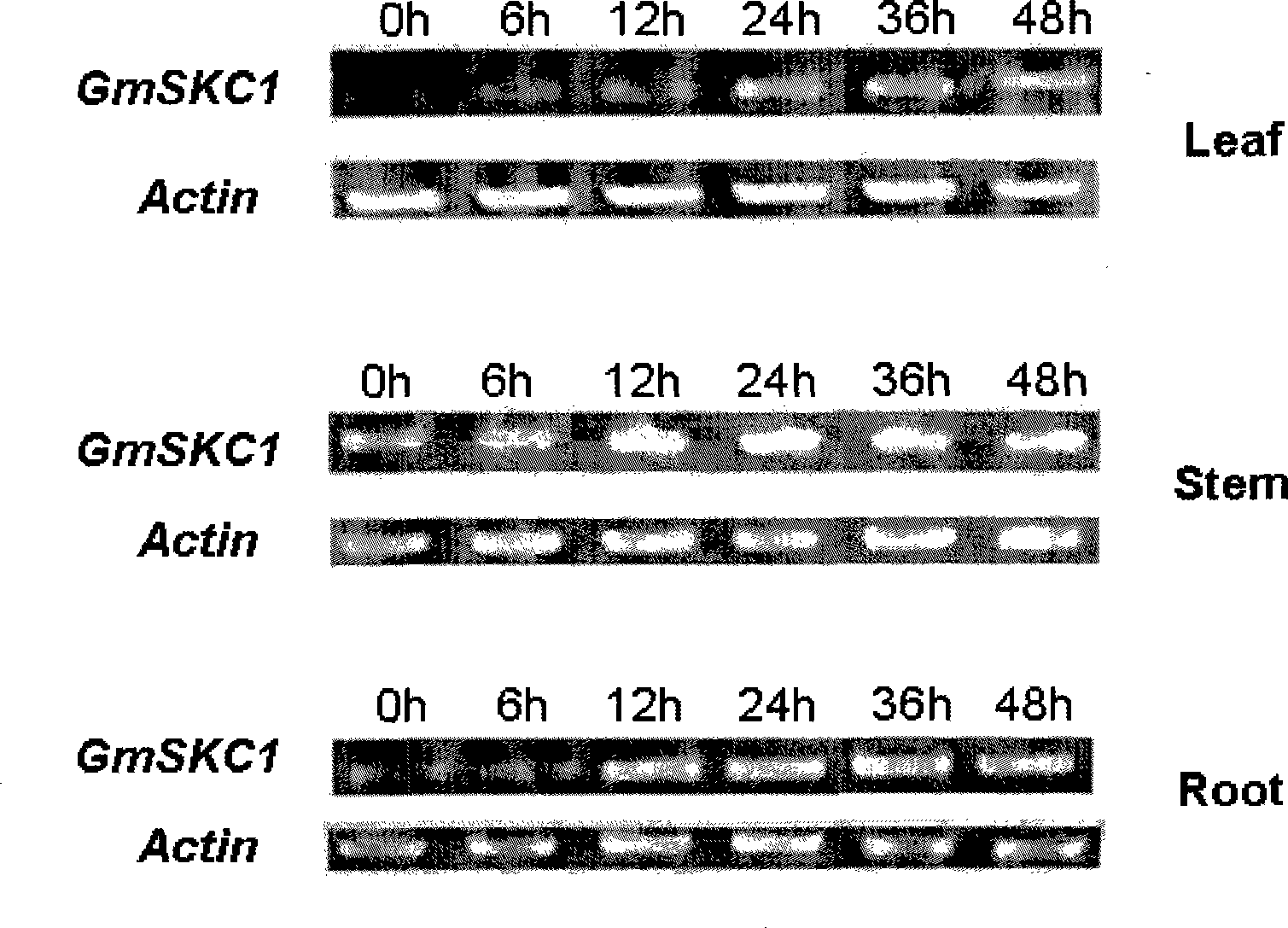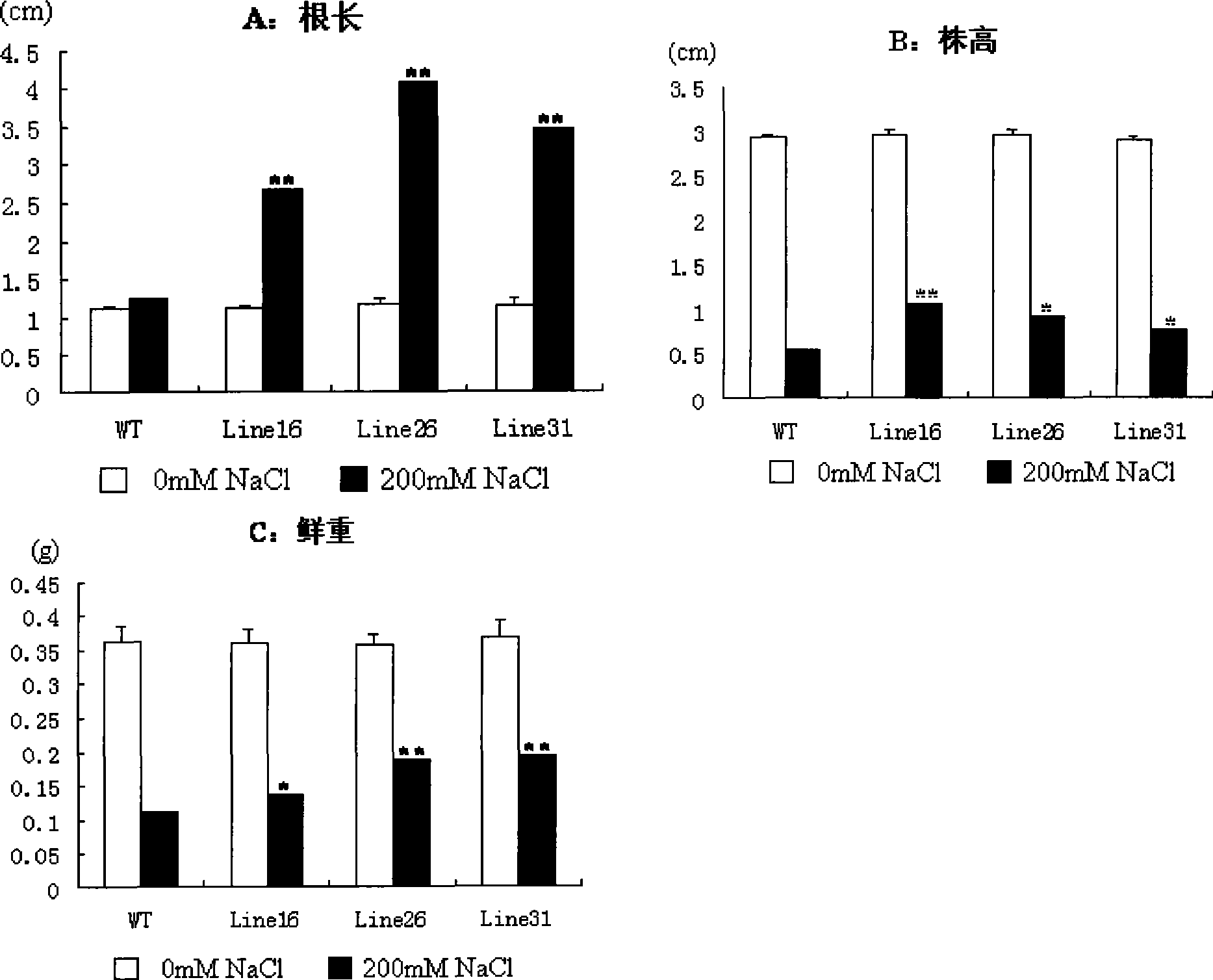Soja bean HKT protein and coding gene thereof and application
A technology that encodes genes and soybeans, applied in the fields of application, genetic engineering, plant genetic improvement, etc., can solve the problem of insufficient research on protein function, and achieve the effect of increasing yield and enhancing tolerance
- Summary
- Abstract
- Description
- Claims
- Application Information
AI Technical Summary
Problems solved by technology
Method used
Image
Examples
Embodiment 1
[0026] Example 1, cDNA cloning and identification of soybean GmSKC1 and its coding gene
[0027] Using the soybean salt-tolerant variety Lee68 (commonly known and public, Abel & MacKenzie, 1964, Crop Science 14, 157-161) as a material, the reported rice HKT protein sequence (OsHKT8, accession number BAB93392) was used as a material by means of bioinformatics. Seed sequence, search soybean EST database, find a highly homologous EST fragment, the gene named GmSKC1. The cDNA of young soybean leaves was used as a template for PCR amplification, and a band with the expected size was amplified. Then, the PCR products were tapped and purified, ligated and transformed, and positive clones were picked for sequencing. Sequencing results showed that the partial sequence of the soybean GmSKC1 gene had been cloned, and its 5' and 3' ends were found to be incomplete. The 3' end was extended and cloned and sequenced. After sequence analysis, it was found that the 3' end sequence was complet...
Embodiment 2
[0031] Example 2, Expression characteristics of soybean GmSKC1 gene under high-salt stress
[0032] Soybean salt-tolerant variety Lee68 was treated with NaCl stress to analyze the expression of soybean GmSKC1 under salt stress. In order to analyze the expression trend of GmSKC1 under salt stress by RT-PCR, the soybean variety Lee68 was planted in hydroponics (Hoagland nutrient solution). The roots, stems and leaves of 6 periods including 0h, 6h, 12h, 24h, 36h and 48h after salt treatment were taken, and stored at -80°C after quick-freezing in liquid nitrogen.
[0033] The extraction of total RNA was the same as in Example 1. Using soybean constitutively expressed Actin gene (GenBankaccession No.V00450) as an internal reference, RT-PCR analysis was performed using total RNA from different soybean tissues and different tissues induced by salt for different time periods as templates. RT-PCR analysis showed that ( figure 1 ), under 150mM NaCI stress, the expression of GmSKC1 in...
Embodiment 3
[0034]Example 3, Functional Identification of GmSKC1 Encoded Protein
[0035] Using Invitrogen's Technology with Clonase TM II kit, insert GmSKC1 forward into the expression vector pMDC83 (Sokolov et al, 2005, PNAS, 103; 9732-9737) ( figure 2 ), the pMDC83-GmSKC1 plant overexpression vector was obtained, and pMDC83-GmSKC1 was transformed into Agrobacterium tumefaciens strain EHA105 (Avsian-Kretchmer et al, 2004, Plant Physiology, 135:1685-1696) by freeze-thaw method. pMDC83-GmSKC1 transformed tobacco through the mediation of Agrobacterium EHA105, PCR detection results showed that 62 positive plants were obtained, combined with RT-PCR analysis results, 3 positive transgenic lines (Line16, Line27, Line31) were selected, and Line16, Line27 and Seeds of Line31 were planted into MS medium, and wild-type tobacco (WT) and T 1 After the generation of transgenic lines (Line16, Line27, Line31) germinated and grew into seedlings (about 15 days), they were transferred to 1 / 2MS basic...
PUM
 Login to View More
Login to View More Abstract
Description
Claims
Application Information
 Login to View More
Login to View More - R&D
- Intellectual Property
- Life Sciences
- Materials
- Tech Scout
- Unparalleled Data Quality
- Higher Quality Content
- 60% Fewer Hallucinations
Browse by: Latest US Patents, China's latest patents, Technical Efficacy Thesaurus, Application Domain, Technology Topic, Popular Technical Reports.
© 2025 PatSnap. All rights reserved.Legal|Privacy policy|Modern Slavery Act Transparency Statement|Sitemap|About US| Contact US: help@patsnap.com



